






















Ships
A partial list of ships that have visited Galápagos over the years.
Click any thumbnail image to view an enlargement of that ship.
A U. S. Navy ship note: According to Executive Order 549, dated January 8, 1907 and signed by President Theodore Roosevelt,
In order that there shall be uniformity in the matter of designating naval vessels, it is hereby directed that the official designation of vessels of war, and other vessels of the Navy of the United States, shall be the name of such vessel, preceded by the words, United States Ship, or the letters U.S.S., and by no other words or letters.
Prior to Roosevelt's Order, ships were often identified by their type: thus, United States Frigate Essex, not U.S.S. Essex. (The periods are omited below, to follow general style seen elsewhere.)
 is a link to a photo of the ship's name carved or painted on rocks at the indicated location.
is a link to a photo of the ship's name carved or painted on rocks at the indicated location.
 is a link to a photo of the ship's name at the Post Office barrel, Isla Floreana.
is a link to a photo of the ship's name at the Post Office barrel, Isla Floreana.
 in an entry below indicates that entry contains links to Google Earth views of places named in the text.
in an entry below indicates that entry contains links to Google Earth views of places named in the text.
As Google Earth views are no longer accessible from links in web pages, the KML files that hold this information must be opened in the Google Earth application. To facilitate this process a special access tool is offered here as KMLDownloader.
 |
Whaling Ships in Galápagos (select image to the left) |
|---|

The California Academy of Sciences purchased the decommissioned U. S. Navy schooner Earnest and renamed it Academy. The schooner departed San Francisco for Galápagos on June 28, 1905 and returned to San Francisco on November 29, 1906. On October 4, 1905, the Academy visited the Galápagos Post Office barrel and Joseph Slevin (1931) noted that
“Crews of various vessels calling at this anchorage had painted or carved the names of their vessels on the post or barrel. Among those are: His Majesty's ships Amphion and Virago, the French cruiser Protet, the USS Oregon, and the USFS [sic, USFC] Albatross.”

The 143-feet long wooden motor schooner left Oslo for Galápagos in 1926.
See Stein Hoff's Drømmen om Galapagos for details.

Launched in December 1882 for the U. S. Commission of Fish and Fisheries, the Albatross made a collecting expedition to Galápagos in 1891 under the direction of Alexander Agassiz of Harvard University. The ship returned to Galápagos on the third Agassiz Expedition of 1904-05. USFC = United States Fish[eries] Commission. The lower illustration (from NOAA Photo Library) is reversed for comparison purposes. Original source unknown.

The Swedish Deep-Sea Expedition sailed from Göteborg, Sweden on July 4, 1947, arrived in Galápagos on August 25, departed October 9 and returned to home port on October 3, 1948. Expedition leader Hans Pettersson described the Galápagos segment in Chapter 7 of his book. Since this Albatross did not visit Tagus Cove, it is not the same ship as that cited immediately below.


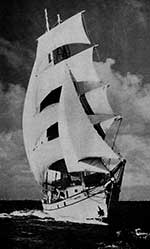
A photo feature of the event appeared in Life Magazine, May 19, 1961.
In 1963, surviving student Chuck Gieg wrote The Last Voyage of the Albatross, and the 1996 film White Squall was based on his book, with Jeff Bridges and Caroline Goodall starring as Sheldon and his wife Alice.

Originally named Concrete due to its ferro-concrete hull, the ship was renamed Albemarle and departed Oslo on September 2, 1926, bound for Galápagos.
See Stein Hoff's Drømmen om Galapagos for details.
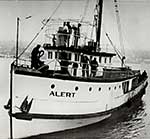
Seattle Times, 12/30/1959: “The 100 ft. refrigerator ship which 30 colonists plan to use for their trip to the Galapagos Islands off the coast of Ecuador is shown pulling into dock here 12/29. The expedition is scheduled to sail on New Years day. UPI TELEPHOTO.”
The colonization project was organized by Don Harrsch, as he described in his Filiate Science Antrorse brochure. After departing Seattle, the Alert was detained in Westport, Washington for safety issues, but eventually reached Wreck Bay, Isla San Cristóbal, on March 16, 1960.

The steel-hulled barque, built in Aberdeen, Scotland in 1874, transported coal from Australia to Panamá. After drifting for weeks, the Captain and crew abandoned the ship in May, 1907 and made their way to Galápagos in two small boats.
See Stein Hoff's Drømmen om Galapagos for details.


William Kissam Vanderbilt II made several visits to Galápagos on his yacht Ara. His book To Galápagos on the Ara: 1926 described his visit of that year.

(to follow).
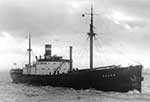
Named after a town in Utrecht Province, Netherlands, the Baarn brought the Wittmer family (Heinz, Margret, Harry & dog Herta) from Rotterdam to Guayaquil in late 1932, as related in Margret Wittmer's What Happened on Galápagos? As with the Boskoop, the Baarn itself did not call at Galápagos, but is included here for historical interest.

The ship was in Galápagos in December, 1937, in company with USS Charleston.
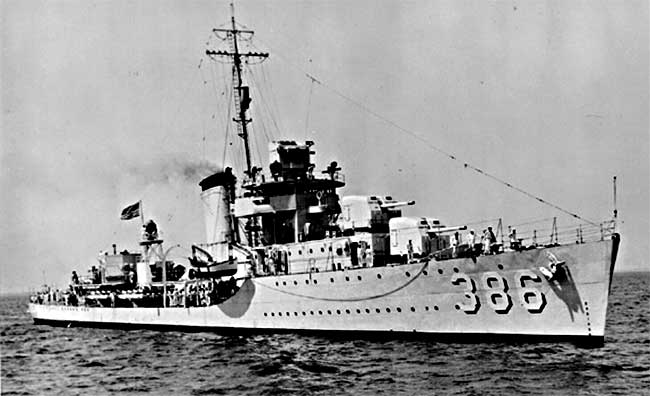
The ship was the third to be named after Ensign Worth Bagley, the only naval officer killed during the Spanish-American war. Launched September, 1936 at the Norfolk Naval Shipyward, Portsmouth, Virginia, the Bagley visited Post Office Bay and Wreck Bay during its August 27-October 4, 1937 shakedown cruise. The ship's post office stamped killer bars and placenames on envelopes at several locations along its route, including two in Galápagos.

Named after Chilean Army Commander-in-Chief Manuel Baquedano, the corvette visited Galápagos in 1910, presumably naming “Bahía Baquedano” after itself. The bay may be the modern Bahía Borrero on Isla Santa Cruz, as described in the Bahía Baquedano section of our Notes page.

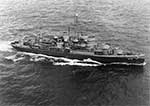
Seaplane tender launched in 1941, and named after Barnegat Bay, NJ. According to Wikepedia, the Barnegat supported the naval air base at Isla Baltra and also established an independent air base at Tagus Cove, enabling patrol bombers to extend their coverage farther off the coast of South America than previously possible. There, she provided fuel for the planes, deployed lighted mooring buoys, billeted and fed the crews, provided bombs and bomb-loading crews, and kept crash and fueling boats in the water at all times.
The ship in which William Ambrosia Cowley, William Dampier and Lionel Wafer visited Galápagos in 1684. The only known occurrence of the ship's name is in Lionel Wafer's New Voyage and Description of the Isthmus of America:
“Captain Swan, in the Cygnet, was going to the Westward; and Mr. Dampier chose to go with him. I staid with Captain Davis, in the Batchelors Delight; and he was for going again to the Southward.”
Presumably, the Batchelors Delight was the Danish vessel captured off the west coast of Africa in November, 1683 and subsequently renamed by the buccaneers. The original name of the ship is unknown.
Information on the spelling of the ship's name is in the Lionel Wafer entry on the Notes (J thru Z) page.

HMS Beagle visited Galápagos from September 14 through October 21, 1835. While Captain Robert FitzRoy and the ship's officers surveyed the islands, naturalist Charles Darwin collected specimens and it has been said that he eventually developed a rather interesting theory to explain what he saw here and elsewhere. Illustrations by R. T. (Robert Taylor) Pritchett are from the 1890 first illustrated edition of Darwin's Journal of Researches.
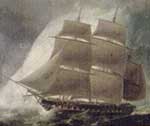
HMS Blonde visited Galápagos from March 17 through April 2, 1825 while enroute to the Sandwich (Hawaiian) Islands with the bodies of the King and Queen of the islands. The painting is by Robert Dampier (no known relation of William Dampier), who was aboard the ship.

Built in 1926, the schooner was purchased in 1933 by Boston businessman Amory Coolidge, who almost immediately sailed it to Galápagos. Coolidge subsequently wrote his A Visit of the Cocos and Galapagos Islands on board the “Blue Dolphin” 1933. The ship was acquired by the U. S. Navy on March 17, 1942, and designated the miscellaneous auxiliary vessel IX 65 (as shown in photo).

Named after a town in South Holland Province, Netherlands, the Boskoop brought Frederick Ritter and Dore Strauch from Amsterdam to Guayaquil, July-August, 1929. As with the Baarn, the Boskoop itself did not call at Galápagos, but is included here for historical interest.

Named after Nathaniel Bowditch (1773-1838), the Bowditch was launched in 1929 in Copenhagen, Denmark, as the passenger ship Santa Inez. It was purchased by the U. S. Navy, outfitted as a surveying vessel, and commissioned 1 July 1940, Commander E. E. Duvall in command. In 1942 the Bowditch conducted a survey in the Galápagos Islands and elsewhere. The ship was decommissioned in 1947.

Sailing in company with HMS Tagus in search of the United States Frigate Essex, both ships arrived at Charles Island (Isla Santa María/Floreana) on July 25, 1814, then continued to other islands before departing for the Marquesas on August 4. The visit―including a brief mention of Lt. Cowan's grave―is described in John Shillibeer's Narrative …. The ship illustration is taken from Shillibeer's Chapter II illustration: “A View of the city of San Sebastian, Island of Cobrus, Rio de Janeiro.”

Built in Scotland in 1884, the ship was acquired by Ecuador in 1886 and given the name Cotapaxi. After the assassination of Manuel J. Cobos, the Cotopaxi was sent to Galápagos to investigate the conditions under which his laborers were forced to work. In 1927 the ship was renamed Calderón in honor of Abdón Calderón, a distinguished leader in Ecuador's independence. The Calderón made several visits to Galápagos, and after being decommissioned it was placed in Guayaquil's Parque de la Armada as a historical museum. [Painting at Museo Naval, 2005 photo at Parque de la Armada.]

Built in 1944, the former US Army supply vessel FS-525 was sold to Ecuador in 1963, and re-named as BAE (Buque de la Armada del Ecuador) Calicuchima. Author Sebastián Donoso reports that the ship sailed periodically from Guayaquil to bring goods and provisions to Galápagos colonists.
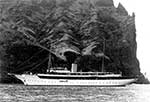
Built in 1928 and presumably named after a suburb of Cincinatti, Ohio, Julius Fleischmann's Camargo visited Friedrich Ritter and Dore Strauch in 1930, as described in Chapter 7 of Strauch's Satan Came To Eden. Although she refers to it as a “black yacht,” the only known photo (at Marquesas) shows it as white. The yacht was sold in 1938 to former Dominican Republic President Rafael Trujillo, and subsequently acquired by the U. S. Navy February 2, 1942 and re-named USS Marcasite (PY-28).

The steel-hulled yacht was built in Germany in 1930 and later purchased by Leon Mandel, who named it after his wife Carola. The Carola visited Galápagos with the Leon Mandel/Field Museum Galápagos Expedition in 1940-41. Purchased by the U. S. Navy in 1942, Carola was converted to the Patrol Gunboat USS Beaumont (PG-60).

Margret Wittmer wrote that the Charleston and Babbitt visited Isla Floreana in December 1937. She stated that a Dr. Mueller from Panama diagnosed her step-son Harry's rheumatic fever. U. S. Navy records show that the Charleston paid a return visit to Galápagos in December, 1939.
The armed tender HMS Chatham, Lieutenant William Robert Broughton, commander, sailing in company with HMS Discovery, passed several Galápagos islands in February, 1795. A carved “Chatham” inscription has been discovered on one of the islands (current Isla Darwin) that were seen from the ship, but no record has been found to verify that the inscription was actually the work of the Chatham crew. See HMS Discovery for details about the voyage.

An envelope postmarked May 29, 1936 indicates the ship was at Valparaiso, Chile on that date. Information on another envelope indicates the Chicago passed Galápagos northbound at 92° 35' West longitude (some 55 nautical miles west of Isla Fernandina), presumably enroute to the Hawaiian Islands. Although killer bars on the envelope include the legend galapagos island, the ship apparently did not actually visit the islands.

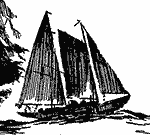
Author Richard Maury (1910-1998) acquired the Cimba in 1930 and set out on a voyage to Fiji, with a stop in Galápagos on the way (July & August, 1934), visiting the Wittmers on Floreana, and then stopping at Tagus Cove on Isabela before continuing across the Pacific. The ship passed through the Panama Canal with the French yacht La Korrigane and met the ship again at Tagus Cove.

The Porter-class destroyer was in Galápagos in August, 1936, where a ship's report stated that “The fishing is unbelievably good.” Whatever other business brought the Clark here is unknown. An envelope postmarked July 15, 1938 bears an illustration with the legend “President F. D. Roosevelt Aboard U. S. Navy Warship on Fishing Cruise to South America.” In fact, President Roosevelt boarded USS Houston on July 14 for a “fishing cruise” to Galápagos, escorted by the USS McDougal. There is no known record of participation by the USS Clark, so the purpose of this envelope illustration remains a mystery. To add to the mystery, the ship depicted in the illustration looks like a WWI heavy cruiser, bearing no resemblance to the USS Clark.
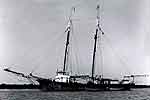
The tyrant Manuel J. Cobos gave his name to the 100 ton motor-sailboat he owned, which made irregular trips between Guayaquil and the islands. After his murder, the ship was re-named as San Cristóbal. In her What Happened on Galápagos?, Margret Wittmer describes her family's arrival at Isla San Cristóbal on the ship in 1932. Jacob Lundh and his mother Helga were also passengers on the same voyage.

The ship was in Galápagos in 1909, in company with USS Maryland (ACR-8), Pennyslvania (ACR-4), West Virginia (ACR-5) and Yorktown (Pg-1).
The first HMS Conway, Captain Basil Hall, visited Galápagos in 1822, as described in the captain's Extracts from a Journal …. The second Conway, Captain Henry Eden, was in Galápagos some twenty years later, and at that time Midshipman G. W. P. Edwardes on HMS Daphne prepared numerous charts, including one showing “Conway Bay” and “Eden (not Edén) Island,” which was subsequently placed as an inset on Admiralty Chart 1375.
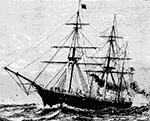
The ship visited Galápagos ca. 1886. While there, Navigation Lieutenant G. A. C. Webb gave his name to Webb Cove, Albemarle Island (Isla Isabela). Cormorant Point and/or Cormorant Bay on Isla Floreana may have been named after the ship. See “Why are there no Cormorants at Bahía Cormorant?” for more details.

See Calderon.

The Cristobal Carrier was one of the first, and possibly one of the worst, vessels to transport tourists between the islands. Photos courtesy of Eva Lewitus (eva@qnet.com.pe), taken on her 1967 visit.

Other than the painted graffiti recording its 1931 visit, no information about this vessel is known.
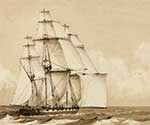
Under the command of Captain John James Onslow, HMS Daphne, a sixth-rate ship launched in 1838, was in Galápagos ca. 1846. At that time, Midshipman G. W. P. Edwardes prepared a chart and illustrations of various islands. His chart is the first to show the names of several prominent British Navy officers. See G. W. P. Edwardes for further details.


The Polish sailing ship Dar Pomorza (“Gift of Pomorza” [Pomerania]) made a round-the-world cruise in 1934-35, stopping in Galápagos in December, 1934. The Dar Pomorza is currently a branch of the Polish Central Maritime Museum, and is moored in the city of Gdynia, Poland.
While at Post Office Bay on December 14, the ship's company replaced the Post Office barrel at Isla Floreana. Several years later (January 24, 1938) a photo of Captain G. Allan Hancock at Post Office Bay shows the sign placed at the Barrel by the Dar Pomorza crew.
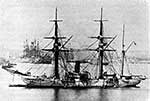
In 1887, the French Navy ship Le Decres, Captain Alfred Charles Marie La Guerre, called at Isla Floreana, where Midshipman M. Estienne surveyed Black Beach. His chart was added as an inset to British Admiralty chart 1376, Anchorages in the Galápagos Islands (Charles Island: Black Beach Anchorage).

On its voyage between Islas Coco and Juan Fernandez, the Sloop of War HMS Discovery, Captain George Vancouver, passed the islands of Darwin, Wolf, Isabela and Fernandina in February, 1795, sailing in company with HMS Chatham. A shore party headed by Joseph Whidbey, Surgeon-Botanist, and Archibald Menzies, Master, briefly visited Isla Isabela, landing to the south of Cape Berkeley.
Read Vancouver's account of HMS Discovery's passage near several islands within Galápagos.


Built in 1906 in England, the Dwyn Wen was used by the U. S. Navy from 19 February 1942 until 18 July, 1944, then sold to an unknown buyer. According to a report in the 10 April 1953 issue of the San Bernardino County Sun:
More than 18 persons are expected to fill out the crew before the Dwyn Wen (“pleasant expectations”) sets sail, probably early in May. First stop is La Paz, then Panama. After that, to the Galapagos Islands and the Marquesas and so on around the world.
From this, the Galápagos visit was presumably made later in 1953. The 1963 University of California at San Diego's South Pacific Deep Ocean Seismic Expedition (which did not call at Galápagos) is described by expedition participant Marge Bradner in her Seismic Summer (PDF download from the University website). She states:
The Dwyn Wen log showed previous entries detailing voyages to the Galapagos Islands … .
Ms. Bradner offers no further details. Saint Dwynwen (5th century) is the Welsh patron saint of lovers but, according to Ms. Bradner, Dwyn Wen means “Pleasant Expectations,” which she may have read in the above newspaper clipping.
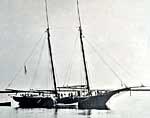
Built in Baltimore in 1875, the U. S. Coast and Geodetic Survey Schooner Earnest was transferred to the U. S. Navy in 1898. After sustaining damage in a storm, the ship was purchased in 1905 by the California Academy of Sciences and renamed as the Academy.

The Patrol Gunboat USS Erie visited Galápagos several times:
On November 12, 1942, the USS Erie was torpedoed by the German submarine U-163 in the Caribbean, and sank a few weeks later while being towed back to the United States for repairs. The USS Erie envelope mentioned above bears an illustration of a three-stack WWI heavy cruiser. Like the USS Clark envelope cited earlier, it bears no resemblance to the ship.

Info to follow

The Essex visited Islas Española and Floreana to repair the ship and take on a supply of tortoises. While at Floreana, Helmsman Thomas Chappel started a fire, which burned out of control for several days. First Mate Owen Chase (23) and Cabin boy Thomas Nickerson (14) both described the visit to Galápagos. Notwithstanding the fire, the Essex might have been forgotten to history, were it not for what happened about a month later.
After departing Floreana on October 23, 1820, the ship sailed westward, reaching about 120° West longitude on November 20—some 2,000 miles distant from Galápagos. There, the Essex went to the bottom after being rammed by a whale. In whaleboats, the surviving crew members took about three months to reach South America, resorting to cannibalism to survive. Herman Melville drew on their story for his Moby Dick, published in 1851.
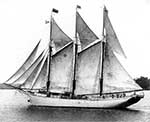
Built in 1919 in Lunenburg, Nova Scotia, the schooner Marshal Foch was purchased by writer Zane Grey in 1924, re-named as Fisherman, and arrived in Galápagos in February, 1925. Grey's Tales of Fishing Virgin Seas recounts the author's experiences here and elsewhere in the Pacific.

The Swedish three-masted schooner Start was renamed Floreana and departed Norway for Galápagos in May, 1925.
See Stein Hoff's Drømmen om Galapagos for details.

On January 28, 2015, the cargo ship Floreana joined the ranks of the Galapaface I, Jessica, Turul, and other ships to go aground in Wreck Bay, Isla San Cristóbal. From its Guayaquil home port, Floreana was carrying about 13,000 gallons of fuel and 1,400 tons of cargo to Galápagos.

According to a news report on the CNH Tours website, the Chinese ship was seized on 13 August, 2017, within the Galápagos Marine Reserve. Upon inspection, some 6,000+ sharks (all dead) were discovered aboard. According to some reports, most or all were loaded from two Taiwanese vessels—Hai Fang 301 and Hai Fang 302—an unlikely situation, given the ongoing conflict between Taiwan and China. In addition, the Caixin Global website claims that a “Taiwan Fisheries Authority says No Local Boat {was} involved in Ecuador Shark Smuggling.” Furthermore, the same report states that the Chinese ship “… spent 12 hours within 30 meters of four Chinese flagged-vessels … about 1,700 miles west of the Galápagos.” Some analysts suggest this is where the transfer took place. If all this is correct, it is unclear why the ship was in transit through the marine reserve. But in any case, the captain and crew have been sentenced to 1-4 years in prison, a fine of US $5.9 million and the ship has been confiscated. (Photo source: Ministerio de Ambiente Ecuador).

Built in 1979, the 2,279-ton cargo ship had about 16,000 gallons of fuel onboard when it went aground May 9, 2014, about 500 feet SSW of Punta Carola on Isla San Cristóbal. Galápagos National Park authorities report there is little possibility of an oil spill into the harbor. However, a May 15 BBC report states that Ecuador has declared an emergency over the possibility that motor oil and other pollutants might spill.

See USS Teal.
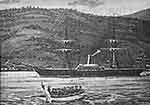
The Geyser had the distinction of transporting a Galápagos tortoise from the Cape of Good Hope to England as a gift for Queen Victoria. An engraving in the July 13, 1877 edition of the Illustrated London News indulges in a bit of artistic license, to show an HMS Geyser seaman, apparently capturing the critter in Galápagos—an unlikely scenario since the ship never visited there. An illustration of the ship has not yet been found, and so her sister ship, HMS Driver, is seen here. Presumably the two were close to identical.
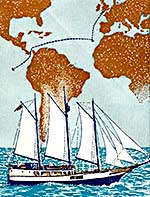
The first tourist vessel in Galápagos, the three-masted schooner arrived from Plymouth, England in 1969. (Photo unavailable—illustration is from maiden voyage postal cover.)

The ship was purchased in 1933 by Dr. Victor Wolfgang von Hagen for his Darwin Memorial Expedition. But in his Chronology of the Darwin Memorial Expedition, [Fall, 1933 section] von Hagen noted that “the times were out of joint” and—despite the accompanying ACME press release (magnifying-glass icon near top of photo)—the ship was sold due to lack of interest from potential supporters. Notwithstanding the “near replica of ‘Beagle,’ ” claim in the press release, the Golden State bore little or no resemblance to HMS Beagle.
| HMS Beagle | Golden State | |
|---|---|---|
| Sail Plan | Brig | Schooner |
| Masts | 2 | 3 |
| Length | 90.3' | 124' |
| Burthen | 242 tons | 223 tons: ACME press release 350 tons: Oakland Tribune report |
Note: A report in the Oakland Tribune (15 February, 1934) states the ship was detained due to a libel suit, which is not mentioned by von Hagen (magnifying-glass icon near bottom of photo). The report gets the names of the ship and the von Hagens wrong, and does not explain why a libel suit was issued instead of a non-payment of funds (or similar) charge.

The yacht was built in 1929 for Fleischmann Yeast's Max C. Fleischmann, who named it after a native tribe living on the Queen Charlotte Islands off the northwest coast of British Columbia, Canada. The Haida was in Galápagos in February and March, 1938 and was discovered taking soundings. For reasons unknown, the Haida hastily departed when local authorities approached it.
Fleischmann sold the yacht to the U. S. Navy in 1940, after which it served as USS Argus (PY 14). In 1946 it was decommissioned and subsequently sold to a private owner. The following year Fleischmann acquired a second yacht, which he also named Haida.

Presumably a whaler, but no information has been found about the ship Halard.

When William Albert Robinson on his yacht Svaap had an appendicitis attack at Tagus Cove, the US Navy sent the USS Hale from the Canal Zone to his rescue. Robinson was transferred to the destroyer and operated on in the ward room by surgeons Lieutenant-Commander R. W. Hutchinson and Lieutenant C. D. Yarbrough.

On December 4, 1871, the United States Coast Survey sent the steamer Hassler (named after the Survey's first Superintendent Ferdinand R. Hassler) from Boston to San Francisco. Survey Superintendent Benjamin Pierce had invited his friend Louis Agassiz to participate in the expedition, with the object of performing dredging operations along the way. The ship arrived in Galápagos on June 10, 1872 and spent about one week there. Although Agassiz, a creationist and strong opponent of Darwin, wrote nothing of this visit, his wife Elizabeth Cary Agassiz wrote “A Cruise Through the Galapagos” for the May, 1873 issue of The Atlantic Monthly.
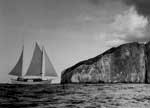
Owner Doug MacIntyre sailed his 28-foot Tahiti ketch to Galápagos, along with cinematographers Conrad Hall and Jack Couffer to film the Walt Disney documentary Islands of the Sea. Although nearby tuna clippers had agreed to bring fresh film from San Diego and transport exposed film there, that arrangement fell through when the fleet abandoned the area to pursue a big run of fish off the Peruvian coast. So Disney sent the Tropic Bird to Galápagos to replace the Highlander, and its owner sailed back to California.

The Houston brought President Franklin Delano Roosevelt to Galápagos on the Third Presidential Voyage. While there, the ship's company unsuccessfully searched for the gravesite of Lieutenant John Cowan on Isla San Salvador. Smithsonian scientist Waldo Schmitt accompanied the President on the voyage.

Launched in 1938, the Canadian merchant ship North Gaspe was torpedoed by German submarine U-203 in 1942. It suffered minor damage, was repaired and subsequently purchased in 1972 by Metropolitan Touring in Quito, Ecuador. It was re-named M/V Iguana, served as a 70-passenger tourist vessel and later as a cargo ship. In 1988 the Iguana sank in Academy Bay. (Photo shows ship prior to purchase by Metropolitan Touring.)
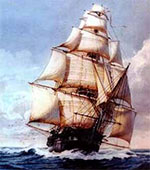
Launched in 1784, Captain John Fyffe brought the ship to Galápagos in June, 1812. According to wikipedia,
During this cruise she gave the second largest island, now known as Santa Cruz island, its English name—Indefatigable.
However, Fyffe's own Chart of the Gallepagos Islands shows that he retained the “Porters Isle” name. The name may have been changed to Indefatigable by cartographer Aaron Arrowsmith in 1817, as mentioned on our Notes page.

Built in 1897, the 51-foot yawl Inyala departed England in August 1930, bound for the South Pacific. With a crew of two, the yawl's captain Temple Utley arrived in Galápagos in early May, 1931. At Isla Floreana, Utley became friendly with Captain Paul Bruun, and in June accompanied him in Bruun's ship Norge to Isla Isabela. On the return trip, Norge ran out of fuel and Bruun managed to bring the ship into Bahia San Pedro on Isla Isabela. From there, Bruun went back to Puerto Villamil for fuel and on his return to the Norge, the small boat he was in capsized and Bruun was drowned. Utley and the others buried him on shore, and in August Utley resumed his own voyage to the Marquesas, Tahiti and Fiji. He resided in Suva, and died there on April 2, 1935.

The famous Captain Paul Bruun with a crew of two brought the former Olav Tryggvasson to Galápagos in 1926. The enlargement shows the Isabela in service in Galápagos. Photo courtesy Thorolf Østmoen.
See Stein Hoff's Drømmen om Galapagos for details.

On January 16, 2001, the Ecuadorian tanker Jessica ran aground at Arrecife Schiavoni, about 800 meters from Puerto Baquerizo Moreno on San Cristóbal Island. The vessel had just arrived from the port of Guayaquil on the Ecuadorian mainland, carrying diesel and bunker fuel. News Releases from the Charles Darwin Foundation and elsewhere reported details.§
§ See also the Turul and Galapaface I entries for other ships that probably struck the same reef about ¾ century earlier and in 2014, respectively.

While cruising off the Galápagos Islands (exact location unknown) in 1941, the German Hilfskreuzer (Auxiliary Cruiser) Komet sank the New Zealand trader Australind on August 14 and the British-India ship Devon on August 19. The Dutch freighter Kota Nopan was captured on August 17, and a German prize crew took the ship to Bordeaux.
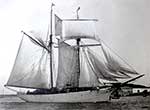
Count (and ship's Captain) Etienne de Ganay, his wife Countess Monique de Ganay, Charles and Régine van den Broek d'Obrenan, and photographer Jean Ratisbonne sailed on La Korrigane,§ passing through the Panama Canal in company with Richard Maury's Cimba. Heinz Wittmer wrote that the ship visited Post Office Bay and someone broke into a locked room and stole his fish spear. The passengers did not visit the Wittmers. Later, they met the Cimba again at Tagus Cove.
§ Korrigan: A fairy or dwarf-like spirit in Breton folkloric heritage. Korrigane is apparently an alternate spelling.


Commissioned in April 1904, the armored cruiser HMS Lancaster was the fourth ship in the British Navy to bear that name. She visited Galápagos in 1917, presumably searching for German warships in the Pacific. The Lancaster was decommissioned two years later.

The minesweeper USS Lapwing (AM-1) was launched 14 March 1918, decommissioned 11 April 1922, and recommissioned 1 September 1932, Lt. R. J. Arnold in command. The Lapwing was redesignated as a Small Seaplane Tender (AVP-1) and visited Galápagos in January 1936, in company with the USS Ranger, Wright, and other vessels. In a 1978 letter, Victor Wolfgang von Hagen states that he was on board the Lapwing and wrote the first Intelligence Report about the Galápagos Islands for the U. S. Navy. According to Frances Conway (The Enchanted Islands, p. 248), in 1940 “The USS Lapwing had been anchored for several weeks in Post Office Bay ….” Margret Wittmer (Floreana Adventure, p. 167) also wrote “That summer [of 1940] we had an American warship actually stationed off Post Office Bay, …” She does not name the ship, but in context it would seem to be the Lapwing.
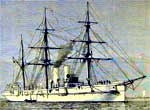
The fourth ship with this name, HMS Leander was launched in 1872 and completed in 1885. In company with HMS Virago, the ship visited Galápagos in 1897, calling at Tagus Cove (December 8-10), where they met the American Lila and Mattie. The ships also visited Post Office Bay, where the Leander put up a new barrel. It is unknown if this was a replacement for an older barrel which had deteriorated, or was the first barrel to be placed here. When the 1905-06 voyage of the schooner Academy visited the same location, the barrel bore a sign that read “Erected by HMS Leander.” The names of HMS Virago, USS Oregon and others were also seen on the barrel. The illustration is from an unknown English paper, dated December 29, 1883.
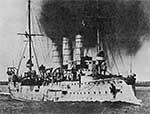
SMS (Seiner Majestät Schiff – His Majesty's Ship) Leipzig visited Galápagos on 18 August, 1914 and one week later sank a British ship carrying sugar (both locations unknown). On 8 December, the Leipzig was near Port Stanley, Falkland Islands, where she was pursued by several British warships, suffered severe damage and was ordered scuttled by her commander, Fregattenkapitän Johannes Haun, who went down with his ship. These details are presented here to clarify information elsewhere that features a dive site near Wreck Bay where there is “The Caragua Wreck — a German WWI steam transport ship that was sunk (allegedly by its own Captain).” The Caragua is actually the former Turul, seized in Australia and re-named as Carawa.
The two-masted schooner was built by John F. Peterson in 1888 for Henry Witherbee. Charles Miller Harris chartered the Lila and Mattie for the Webster-Harris Galápagos Expedition of 1897.

The M/V Lina A was the second tourist ship in Galápagos, where it went into service on December 4, 1969, shortly after the arrival of the Golden Cachalot.

The USS Mallard was commissioned as a minesweeper, AM-44, in 1918 and reclassifed as a Submarine Rescue Ship, ASR-4, in 1929. She was attached to Submarine Squadron Three, whose home port was Coco Solo, Panama before and during WWII. In April, 1941, she accompanied four submarines (S-44 - S-47) to Galápagos, where they charted the waters surrounding Isla Baltra. See Picking, Sherwood for more details.

On a return visit from Australia, the Omaha class light cruiser surveyed Tower Island, Darwin Bay, in 1925. Further details, if any, are unknown.

The ship was in Galápagos in 1909, in company with USS Colorado (ACR-7), Pennyslvania (ACR-4), West Virginia (ACR-5) and Yorktown (PG-1). According to a February 14 entry in a log kept by Seaman Fred Sanford Rice, “We are to take surveys, some say the Government is looking for a good site for a coaling station.”

An envelope bearing a USS McCormick postmark dated May 22, 1940 was placed in the Post Office barrel on Isla Floreana. The purpose of the Galápagos visit is unknown, pending further research.
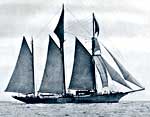
Gifford Pinchot's 148-foot three-masted schooner was built in Wilmington, Delaware in 1902 as the Ariadne and later named Cutty Sark. When Pinchot acquired the vessel he re-named it Mary Pinchot in honor of his mother. He sailed from New York on April 1, 1929, bound for Tahiti. The voyage, including a five-week stopover in Galápagos, is described in his book To the South Seas.

Launched in 1926 at Newport News, Virginia, the yacht was acquired a few years later by Zenith Radio Corporation founder Eugene F. McDonald, named Allegro and in 1929, re-named as Mizpah. The following year, McDonald sailed to Galápagos and visited Friedrich Ritter and Dore Strauch. Strauch wrote about the Mizpah in her book Satan Came to Eden (Chapter 7), and even Dr. Ritter recalled McDonald's gift of a wheelbarrow, as reported in his 1931 Atlantic Monthly feature, “Satan Walks in the Garden, ” and later by J. F. Schimpff. Strauch reported the visit occurred on January 18th, but McDonald gives the date as January 25. Ritter subsequently corresponded with McDonald, and with Dr. Baker Brownell, a Professor of Contemporary Thought at Northwestern University and McDonald's guest on the Mizpah. The yacht was subsequently acquired by the U. S. Navy and commissioned as USS Mizpah (PY-29) in 1942, decommissioned in 1946 and scuttled as part of an artificial reef off Palm Beach, Florida in 1968.

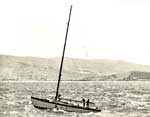
Bernard Gorsky's Moana departed St. Malo, France on June 28, 1954, arrived at Isla Genovesa on March 29, 1955 and departed Isla Santa Cruz on April 20 on a course for the Marquesas Islands.


The ship was a UNOLS (University-National Oceanographic Laboratory System) research vessel commissioned in 1973 and operated by the University of Hawaii. It may have visited Galápagos in 1974 and if so, that might account for the “Moana 74” graffiti at Tagus Cove.
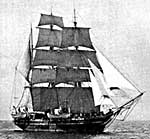
The whaling bark Morning Star of New Bedford, Connecticut made several visits to Galápagos ca. 1858-61. Source: Townsend, The Galápagos Tortoises in their Relation to the Whaling Industry (Figure 20).


The Noma was built in 1902 for William B. Leeds, and subsequently sold to John Jacob Astor, father of William Vincent Astor. After the elder Astor's death by drowning when HMS Titanic sank in 1912, ownership passed to his son, who loaned the Noma to the U. S. Navy in 1917 for use during the First World War. At war's end, the ship was decommissioned in 1919 and returned to her owner. In 1921, William Vincent Astor replaced the Noma with a new yacht which became the second Astor yacht to bear the name Nourmahal. In 1923, the Noma was used by William Beebe and other members of the Harrison Williams Galápagos Expedition, as described in Beebe's Galápagos: World's End.
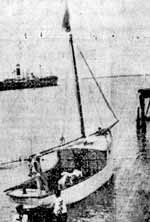
Norwegian Paul Edvard Bruun served for a time as captain of the Manuel J. Cobos, and later settled on Isla Floreana. From there, he operated his own ship Norge. In June, 1931, Bruun sailed the Norge over to Isla Isabela, accompanied by author Temple Utley, who had arrived in Galápagos on his yawl Inyala. Utley describes Bruun's death at Bahia San Pedro in his book A Modern Sea Beggar.
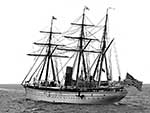
Built in 1884, John Jacob Astor's yacht Nourmahal had nothing to do with Galápagos. It is nevertheless listed here to help distinguish it from the second and third Nourmahal yachts, both described immediately below.
In Thomas Moore's Lalla Rookh: An Oriental Romance, the Princess Nourmahal is the heroine of Moore's poem “Light of the Harem.” The reason Astor named his yacht after the princess is unknown, pending (as usual) further research. In 1910, Astor replaced Nourmahal with the yacht Noma, purchased from William B. Leeds.

Built in 1921, and like its predecessor having nothing to do with Galápagos, this Nourmahal replaced Astor's Noma, mentioned above.


William Vincent Astor's third yacht Nourmahal, built in 1928 at the Krupp Iron Works in Kiel, Germany, replaced his previous yacht of the same name. In 1930 (March 23-May 2), Astor took a group of scientists to Galápagos aboard the yacht, and made additional visits in 1932, 33, 36, 37 & 38 (see graffiti). Acquired by the U. S. Coast Guard 21 March 1940, the yacht was subsequently assigned to the U. S. Navy in 1942 and designated USS Nourmahal (PG-72).

The ship stopped at Post Office Bay in January, 1898 on a voyage from Callao, Peru to Honolulu, Hawaii. [See Academy note above.]

Launched in April, 1903, the USS Pennsylvania was at Callao, Peru in 1909. Excerpts from the Fo’csl Log for that year indicate the ship's visit to Galápagos:
Feb 10: Callao. Both Squadrons left today at 4:00 PM for the Galapagos Islands, distance 1,021 miles. All hands happy as it means that we are nearing the good old U.S.A.
Feb 13: At Sea. Turtle-shell, Souvenir hunters, Fishermen, Seine men and Nimrods of all sorts breaking out their gear as there is to be lots of liberty granted at the Galapagos Islands
Feb 14. Chatham [sic, Floreana] Island. Post Office Bay Galapagos Islands, Equator [sic, Ecuador]. We arrived here at 2:00 PM with the West Virginia and Colorado; other ships of the fleet [USS Maryland, Pennsylvania & Yorktown] went to other Islands in the group.

Named after Pine Island Sound, Florida, the seaplane tender (AV) was launched in 1944, de-commissioned May 1950, re-commissioned six months later and finally de-commissioned in 1967. The ship visited Galápagos in January-February, 1964 where she assisted scientists in the Galápagos International Scientific Project. The project, and a brief mention of the Pine Island (pp. 8 & 11), was described by Drs. Nathan Cohen and Robert Bowman in Noticias de Galápagos, vol 3, 1964 (now online at the above link).
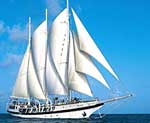
George Washington Vanderbilt III visited Isla Floreana on June 4, 1941 on his yacht Pioneer. While there, an expedition member picked up envelopes mailed from the Post Office Barrel by commanding officer Lieutenant Ian C. Eddy and crew man Fred Gerlach on the submarine USS S-45.
There is conflicting information about the yacht's early history. One account states it was the former German yacht Cressida, built in Kiel, Germany in 1927, captured as a war prize during WWII and subsequently sold to Vanderbilt, who re-named it as Pioneer. However, a June 7, 1937 Time Magazine account indicates Vanderbilt was on his yacht Cressida in Hawaii, and the above envelope indicates his Pioneer was in Galápagos shortly before the war. Pending further investigation, about all that can be stated for sure is that the former Pioneer was operated by Windjammer Barefoot Cruises as the S. V. Yankee Clipper, shown in the thumbnail image (larger photo not available). However, the company suspended operations in 2007, and a Wikipedia article states its Yankee Clipper and other yachts are now laid up in deteriorating condition.
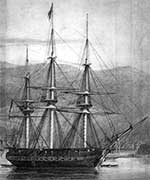
The ship visited “Essex Bay” (the modern Post Office Bay) in August, 1833 on its round-the-world cruise. The visit was described in books written by Jeremiah Reynolds and Francis Warriner. Only the latter mentioned meeting an Englishman—presumably, Nicholas O. Lawson.
The foldout illustration from Reynolds' book is based on a painting by J. Searle; “View of the Harbour and Town of Valparaiso.”

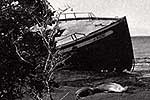
Other than its name, nothing is known of the Radio, which is thought to have been a tuna fishing vessel. The photo was taken on one of the Hancock Expeditions between 1931 and 1935. Today, all that remains of the Radio is an engine casing lying in a tide pool, which some naturalist guides inform their passengers was dropped there during WWII by American military forces. The ship is briefly mentioned in Richard Maury's The Saga of “Cimba.”

The USS Ranger—the first U. S. Navy ship built from the keel up as an aircraft carrier—was commissioned on 4 June 1934, Captain Arthur L. Bristol in command. The Ranger arrived in the Pacific in April 1935. In January, 1936, she visited Galápagos in company with USS Wright and other vessels.
Launched in 1783, the 16-gun sloop HMS Rattler was sold in 1792 to the whaling company Samuel Enderby & Sons, where—no longer HMS Rattler—it became the Merchant Ship Rattler. Commanded by James Colnett, it visited Galápagos in 1793, as described in Colnett's A Voyage to the South Atlantic … .
The ship in which William Ambrosia Cowley, William Dampier and others departed Virginia in August of 1683. The authors contradict each other on describing the vessel though.

These four vessels in Submarine Squadron Three visited Galápagos in April, 1941, accompanied by the USS Mallard. Captain Sherwood Picking was Squadron Commander.


The British three-masted barquentine departed Dartmouth, England on April 9, 1924 on a voyage to the Marquesas and Society Islands and back. The St. George arrived at James Island on July 24, and later visited several other islands. In The South Seas of To-Day, author P. H. Johnson wrote about the names of ships seen at Tagus Cove:
“Previous visitors had a habit of inscribing their ships' names and the date of their visit on the sides of the gully. Unfortunately, Darwin's ship, the Beagle, seems to have omitted to do so, though there is a record of the visit of the Phoenix in 1836, the same year as he was here. [sic, Darwin was there in 1835.] However, the St. George's name has not been forgotten, and now stands there are large as any of them.” [The ship's company also erected a new Post Office barrel in August, 1924.]

See Manuel J. Cobos for details about the ship re-named San Cristóbal after the murder of Cobos.
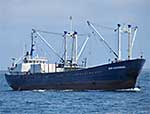
The cargo ship San Cristóbal (SAN CRISTOBAL on hull) made regular runs between Guayaquil and Galápagos. On November 17, 2014, it quickly sank about 25 miles off the coast of Ecuador, and so the sinking posed no threat to the Galápagos environment. The San Cristóbal was carrying about 1,200 tons of cargo, including two vehicles. All crew members were rescued by the Ecuadorian Coast Guard.

When William Albert Robinson had an appendicitus attack on his yacht Svaap, Captain Anton Hage and the crew of the tuna fishing boat Santa Cruz stood by to adminster emergency care and to look after Robinson's wife Florence and his cousin/cook/artist Daniel T. West. The opening page of Robinson's “A Debt I Owe” chapter shows the drawing seen here—unidentified, but in context no doubt the Santa Cruz as rendered by West.

The tuna fishing boat's crew were the first to discover the bodies of Rudolph Lorenz and Trygve Nuggerud on Isla Marchena. The ship's name is frequently seen misspelled as Santa Amaro.
Alexander Mann, a Scottish merchant and long-time resident of Guayaquil had the steel motor-schooner built for him in 1901. He and his brother departed Guayaquil on February 7, 1907 for a cruise to Galápagos. They began their return voyage on March 21.
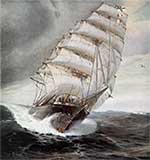
Launched in 1878 as the American Pass of Balmaha for the Harris-Irby Cotton Company, the ship was captured by the British and later by the Germans, who renamed it Seeadler, and placed it under the command of the famous Count Felix von Luckner, who acquired the nickname Seeteufel (Sea Devil). Although Seeadler did not make it to Galápagos, the Seeteufel himself did, as described immediately below.
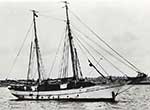
In 1937-39, the German Count Felix von Luckner made a world cruise on his yacht, named Seeteufel after his own nickname (see entry immediately above). Along the way, the Seeteufel called at Galápagos and the Count paid a visit to the Wittmers, which Margret Wittmer recounted in her Floreana Adventure. The photo shows the yacht presumably some years later and somewhat the worse for wear.
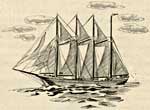
The four-masted schooner Georgette was acquired by Phillips Lord in 1933, who re-named it Seth Parker after the country preacher character he played on his radio show. On November 13, 1934, Lord visited Dr. Ritter and watched as Ritter tossed some pork to his chickens. While visiting the Wittmers the following day, the ship's crew reported that the chickens had died of meat poisoning. The second image shows the endpaper illustrations from a 32-page Aboard the Seth Parker booklet published by Frigidaire Sales Corporation to publicize the use of Frigidaire equipment on the ship. The photos that follow show the ship at various stages in its life.

Yacht used by Tucker McClure construction company during WWII occupation of Galápagos by American military forces. No other information is available.

On September 1, 1919, the USS South Dakota was ordered to the Pacific to serve as flagship of the Asiatic Fleet. On September 15, the ship left the Panama Canal, bound for the Galápagos Islands. She departed Galápagos on September 18 and after several more stops, arrived in Manila on October 27.

Launched in 1927 by Norway's Bergenske Dampskipsselskap (Bergen Line), the ship visited Post Office Bay on January 30, 1934, at which time Captain G. Allan Hancock was also there on the third voyage of his Velero III, as was Danish journalist Hakon Mielche on the yacht Monsunen (“Monsoon”).
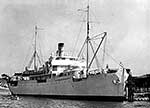
Frederick E. Lewis brought his 230-foot, 297-ton diesel yacht from New York to Long Beach, California in 1935-36, with an extended visit to Galápagos along the way. A group of Orange County California Sea Scouts served in the crew, and in Galápagos collected iguanas, penguins and other birds which were subsequently given to the San Diego Zoo. According to Victor Wolfgang von Hagen (p. 3 of his “Chronology” sent to Corley Smith), he boarded the ship in Galápagos and the Sea Scouts served as his assistants. The Stranger returned to Galápagos in February-March, 1937, again with Sea Scouts serving in the crew.
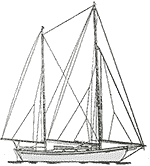
In May, 1934, William Albert Robinson anchored his yacht Svaap at Tagus Cove, Isla Isabela, as described in his Voyage to Galapagos (pp. 241-256). While awaiting the arrival of USS Hale to transport him back to Panama (after emergency surgery on the Hale's wardroom table), he was “packed in ice” by the crew of the tuna fishing boat Santa Cruz.
Sailing in company with HMS Briton in search of the United States Frigate Essex, both ships visited Galápagos in July and August, 1814.

The Wickes-class destroyer was named after Joshua Frederick Cockey Talbott (1843–1918), Representative from Maryland Second District in 1879-1885, 1893-1895 and 1903-1918. It was in Galápagos in 1941, when a crewman (name unknown, initials C. G. F.) placed a letter in the Post Office Barrel, addressed to a William F. Cook.

Sailing in company with the USS Erie, the Wickes-class USS Tattnall visited Galápagos in August, 1940.

Launched in 1918 and 1919 respectively, the Teal and Gannet (shown in photo above) were reclassified AVP-5 and AVP-8 (small seaplane tender) in 1936. The ships traveled to Galápagos in company with USS Wright and other vessels in February of that year.

The R/V (Research Vessel) Te Vega was acquired by Stanford Univerity's Hopkins Marine Station in 1962 and was sold to the Flint School in 1969. The ship visited Galápagos in the summer of 1968, and after being sold returned there in 1969. On the latter voyage, it apparently visited the Post Office barrel on Isla Floreana and picked up an envelope deposited there by a passenger on Metropolitan Touring's Lina A. The envelope was subsequently mailed from Costa Rica.

Built in 1930, Thomas M. Howell's 160-foot yacht Thalia visited Galápagos in 1934. A November 20, 1934 report in the Miami Daily News mentioned the ship's visit in April, and a July 7, 1935 article in the same paper by Miami photographer Claude C. Matlack stated that the ship called at Floreana on April 21-22. Margret Wittmer recorded an April 21 visit in her unpublished “What Happened on Galápagos.”
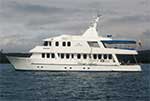
On 24 April, 2015 at approximately 0400 hours local time, the Tip-Top II “suffered an accident” in the vicinity of Bahía Tortuga, Isla Santa Cruz. All 16 passengers and 8 crew members were rescued by other vessels. According to at least one passenger, “This did not happen due to strong tides. … the skies were clear, the ocean no more rough than usual.” (Source: “Tip Top II Accident” on tripadvisor.com website.) Further details will be posted here when (and if) they become known.

In company with USS Marblehead and others, the Omaha class light cruiser visited Australia and New Zealand in 1925, stopping at Galápagos on the way back to home port in Philadelphia. The Trenton visited Galápagos again, calling at Hood Island (now, Isla Española) in 1935.


The 40-foot ketch was sent to Galápagos to replace the Highlander when the latter returned to California. Cinematographers Conrad Hall and Jack Couffer boarded the Tropic Bird to continue the Disney film. During a visit to Tagus Cove they painted the ship's name on the rocks, along with a depiction of a movie camera.

Built in 1907, the home port of the single-screw steam freighter Turul was at Fiume, an Adriatic seaport within the Austro-Hungarian empire, which is now in the modern Croatia. The Turul (a mythical bird in Hungarian folklore) was seized in Sydney, Australia in the early days of World War I (August, 1914) and re-named in 1915 as Carawa (placename on southern coast of Australia). Enroute from Port Arthur, Texas to Brisbane, Australia (Captain J. H. Hyde) with a cargo of gasoline, it stopped at Isla San Cristóbal and on March 21, 1920 struck a reef at Wreck Bay—no doubt Arrecife Schiavoni  .§
.§
§ See Notes page for information about Arrecife Schiavoni coordinates. See the Galapaface I and Jessica entries above for other ships that struck this reef.
From the account in Stein Hoff's Drómmen om Galapagos, it would appear that one of the Norwegian settlers was mis-informed about the details of the ship's destruction:
The Turul “ … had a large cargo of kerosene when the British sank her during World War I.”
There is of course no known record of any British activity in Galápagos during this war, which had ceased long before the ship went aground. And having been re-named several years earlier, it is unknown why the Norwegian account refers to the ship by its original name. One possibility is that Carawa had been painted over a Turul name plate, and after striking the reef, salt water eventually wore away the painted name, once again exposing the Turul name plate. A similar occurrence may be seen above in photos of the Seth Parker stern, where its former name and home ports are once again visible due to weathering.
There is also some circumstantial evidence that the ship was not the Turul/Carawa. According to a 12 July 1920 survivor's report in The Argus (Melbourne, Australia newspaper):
The Carawa struck a reef about a mile from the shore. The rudder and stern post were torn away and the vessel became hard and fast. We remained on her for four days, when the high tide floated her off the reef into deep water. The Carawa sank in about 40 feet of water. Her masts, funnel, and bridge could be seen above water.
Given that the ship sank in deep water long before the Norwegians arrived in 1926, they may have seen traces of a more-recent accident, and assumed in error that it was the Turul. Or as yet another possibility, local divers may have retrieved the ship's bell, which would have had Turul engraved on it. The Norwegians may have seen the bell and thus identified the ship by that name.
Photo courtesy Captain József Horváth and the editors at the Hajó-Regiszter website.
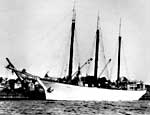
Constructed in 1919, the wooden motor-schooner was overhauled prior to its 1926 departure for Galápagos.
See Stein Hoff's Drømmen om Galapagos for details.

In 1958, Los Angeles attorney William Rhodes Hervey visited Galápagos on his yacht Valinda. While anchored off Isla San Salvador, convicts from the Isla Isabela prison seized the yacht and forced him to take them to mainland Ecuador. Hervey's Captured at Sea … described the incident.


Captain G. Allan Hancock made five voyages (1931-1938) to Galápagos on his cruiser, which was equipped for scientific research expeditions.

The Italian corvette, Captain Giovanni Palumbo, visited Galápagos March 20-31, 1884, calling at Islas Floreana and San Cristóbal, where Wreck Bay was surveyed. The survey was added as an inset to British Admiralty Chart 1376: “Chatham Island:Wreck Bay to Stephens Bay” The inset shows “Foche I.” (the modern Isla Lobos), presumably so-named by the Italian cartographer.

Commissioned in 1862, the Sloop of War was active in the Pacific from 1880 until 1885. In 1884, the Wachusett visited Galápagos, where Dr. William H. Jones collected mollusks on Chatham Island (Isla San Cristóbal) for the Smithsonian Institution.

The ship was in Galápagos in 1909, in company with USS Colorado (ACR-7), Maryland (ACR-8) and Pennyslvania (ACR-4). The ships visited Charles (Isla Floreana), Albemarle (Isla Isabela), and (USS Maryland only) Indefatigable (Isla Santa Cruz). Charles E. Ellis, one of the crewmen, apparently photographed an officer, in civilian clothes, trying to kill a sea lion at Charles Island.

Gerry Trobridge designed and built the White Seal [so-named after a Rudyard Kipling story] in South Africa and set out on a circumnavigation in 1953, returning to Durban in 1959. He met and married Marie in 1957, and they arrived in Galápagos in mid 1958. [Source: Holm's The Circumnavigators.]

The USS Wright was commissioned at the New York Navy Yard on 16 December, 1921, and designated as a lighter-than-air aircraft tender (AZ-1). She was reclassifed as a heavier-than-air aircraft tender (AV-1) on 1 December, 1926. Between 16 January and 28 February, 1936, she participated in an aviation support cruise which visited Post Office Bay, Galápagos Islands, Santa Elena, Ecuador and Balboa, Canal Zone. She traveled in company with the USS Gannet, Lapwing, Ranger and Teal. Renamed San Clemente in 1945, the ship was sold for scrap in 1948.

Hans and Lotte Hass visited Galápagos as part of a 1953 underwater filming expedition on their three-masted research vessel Xarifa (“Charming Lady” in Arabic)
Photo source is postcard sent by Lotte Hass to Dr. Hugo Mauerhofer.

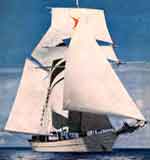
Irving & Electa “Exy” Johnson owned three ships, all given the same name. Each entry begins with the year the ship was acquired by the Johnsons. A table summarizing their seven circumnavigations appears on the Notes page.
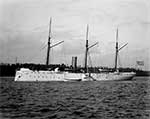
Launched in 1888, the Gunboat was decommissioned several times, then recommissioned on 1 October 1906. The ship visited Galápagos in 1909 and while there surveyed Cartago Bay. Perhaps other areas were also surveyed, for according to a “South America Not Popular” report in The Liberty Bell, published aboard the USS Pennsylvania, …
We can all sympathize with the ship's company of the U. S. S. Yorktown, having to stay at the Galapagos Islands for the next three or four months. It is almost as monotonous as the last six months of our cruise and is very nearly as lively a place as Tuituila, Samoa.
Charles Island of the Galapagos group, though uninhabited, can boast of a postoffice or at least a mail box. It is a barrel painted red and white, with the notice ‘Post Office’ painted in large letters on the side.


Templeton Crocker had his wooden-hulled, schooner-rigged 118-foot yacht built in 1929-30, and the Zaca visited Galápagos during the 1932 (March-September) and 1934-35 (September-April) Templeton Crocker expeditions. Various sources state that Zaca is:
Acquired by the U. S. Navy during World War II, the Zaca was subseqently purchased by actor Errol Flynn.

On a six-month voyage from Boston to San Pedro, California in 1937, the Zavorah, Captain Charles Hubbard, visited Islas San Cristóbal, Floreana and Bartolomé, and crew member Tom Johnstone took photos of several places visited.
The Panama Canal Record lists the Zavorah's passage through the canal (Atlantic to Pacific) on February 15, 1937. No other record has been located (yet).